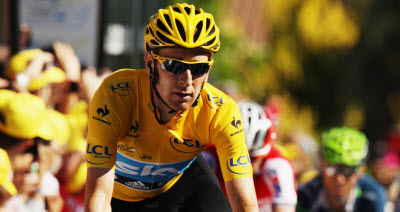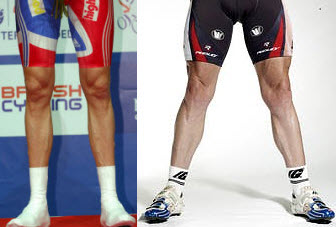
Besides sporting those fabulous sideburns, Tour de France leader Bradley Wiggins is demonstrating how to climb effectively using a much faster pedal cadence than the riders that surround him. I've been counting his pedal RPM during the climbs and today as I watched, Wiggins climbed the Col de Tormalet in the high 80's. Wiggins reminds me of another successful high cadence climber - Lance Armstrong. I'm going to venture a guess that this year's presumptive winner has a similarly superhuman aerobic capacity.
Climbing hills outdoor as a group requires everyone to develop the same amount of power, relative to the combined weight of the rider and bicycle. When we discuss cuing a climb in class we shouldn't give a random wattage - I want everyone at 300 watts!!!!, but rather normalize each a rider's power output as it relates to their body weight. For example you may say; for us to stay together as a group we all need to be maintaining one watt per Lb.
How a cyclist creates power can vary by changing the two components that make up power; force (pedal torque) and speed (cadence/RPM).
- The force you apply to the pedals while seated is primarily developed through muscle contractions. Yes, BIGGER muscles can create more force.
- The speed that you you apply these contractions is very dependent on the availability of oxygen, which makes high RPM pedaling more a function of your aerobic system.

Wiggins vs. Evans
When you see Bradley Wiggins standing next to other riders, it's quite obvious that he doesn't posses the large muscles of many of his competitors. You may actually say that he has "skinny" legs compared to last year's winner Cadel Evans in this picture.
NOTE: If you've got people in your class who are concerned with getting "big legs" from cycling you can show them this picture. Explain that, as a professional cyclist, if Bradley Wiggins could develop the muscular size of Evan's legs, he would... but he probably can't due to his genetic makeup.
So, for Mr. Wiggins to maintain his place at the front of the peloton, while riding alongside Mr. Evans, Mr. Wiggins needs to produce the same watts per Lb (or Kg) as Cadel. No more and no less... the exact same watts per Lb. Not able to develop the same amount of force as others... he makes up for it by applying more frequent (yet smaller) forces on his pedals = higher cadence.
So - how to bring this concept into your class?
If you're teaching with power it's easy. Create a profile that calls for specific watts per Lb at varying pedal RPMs with the intent of exploring which RPM equates to the lowest heart rate, with a fixed watts per Lb. My experience is that each RPM level needs to be maintained for 3+ minutes so your student's effort can stabilize, before making a change.
But what if you don't have power?
As part of my Wine Country Audio PROfile, I added some additional information that I feel will benefit you on days where you're encouraging faster climbing cadences... but don't want everyone's pedals running away with them.
How you cue the addition of intensity is very important in an Indoor Cycling class of any format and its different dependent on the type of Indoor Cycle you’re riding.
- With any Indoor Cycle that uses friction to create the resistance I suggest adding resistance to cadence. Class is pedaling ~ 90 RPM and then add load to reach intended intensity.
- If you are riding a FreeMotion S11, Keiser M3 or Schwinn AC with magnetic resistance you can add resistance to cadence or you can do the exact opposite, adding cadence to resistance. You’ve never heard that before, have you? It’s why I see magnetic resistance as being superior.Here's why
My biggest struggle (besides getting people to be quiet) is how to best communicate load in class. If you have been paying attention, you have noticed that with a friction based resistance system as you slow your cadence the pedals get heavier. We have all seen the person who was supposed to be accelerating out of a climb start bouncing like they have no resistance at all. This happens because as your student pedals faster, the added centrifugal force overcomes the fixed amount of friction, making it easier and easier to pedal, until it’s like they have no load at all. Not Good 🙁 Cycling is all about endurance. We want them to endure it! The solution is to establish leg speed and then adjust load to regulate the work they are doing.Indoor cycles with magnetic resistance (S11, M3 and AC) work very differently. As the speed of the flywheel increases, the Eddy Currents that create the load increase as well. So these Indoor Cycles actually get harder to pedal as cadence increases, just like a real bicycle. So with these types of cycles cue your students to set their load at a slower RPM and then simply increase cadence to add intensity.
Give this a try and let me know if it helps [wlm_firstname]
Originally posted 2012-07-18 16:26:11.

John
I’m somewhat surprised that there are not more comments. I conclude that we are the lucky few that teach on indoor cycles that use magnetic ‘eddy current’ resistance.
I have heard this before, but alas, old habits die hard.
That said, last night while doing a 90 minute TDF stage ride to video I decided to change it up a bit by starting with low cadence adding some load then having the riders add cadence. As they were watching the video, my cues to increase cadence were not questioned.
Over 90 minutes I was able to take them up in cadence let them slow for some recovery, add a bit more load then take the cadence up again four times.
Fortunately the video was of a medium mountain stage with a summit finish. So the roads were relatively flat looking most of the time and summit finish was their opportunity to load it up, get up and power up to the summit.
A great use of this technology. Thanks for sharing.
I’m totally with you on everything, but the watts per lb guidance confuses me. I’ve heard it before.
I’m 130 lb woman, and in pretty good shape for 45. My warm up wattage is typically around 180, at a very comfortable 80 rpm’s. Asking me to “work” at 130 watts would be unrealistic. Likewise, if I were to suggest to a 200 lb unfit woman entering my class that she work at 200 watts, I would be setting her up to walk out of the room feeling defeated.
I genuinely feel as though I’m missing a key piece of information that would help me understand this, and I would love to have a way to “level the playing field” so to speak. Help!
I completely understand Jennifer and I’m guessing that “in pretty good shape for 45” is a bit of an understatement 🙂
1 watt per lb is a concept the guys at Cycling Fusion introduced as a measure of fitness where you can start to tackle some reasonable climbs – so it’s more of a goal for many people. My main purpose of this post was to help you communicate how everyone needs to maintain the same watts per lb if we are going to stay together on a climb. It’s not a replacement for power training zones based on Functional Threshold Power FTP. Cameron Chinatti does a good job explaining FTP here https://www.indoorcycleinstructor.com/icipro-instructor-training/pro-podcasts/icipro-podcast-206-understanding-ftp-functional-threshold-power-with-cameron-chinatti/
Ah! Thank you!